Diagnosing Changes of Winter NAO in Response to Different Climate Forcings in a Set of Atmosphere-Only Timeslice Experiments
Abstract
:1. Introduction
2. Models, Experiments, and Methods
2.1. Modelsand Observational Data
2.2. Experiments
2.3. Methods
3. The Changes of Winter NAO Variability in Response to Different Forcings
The Decomposed Changes of SLP Patterns of Winter NAO
4. Possible Causes of the NAO Variability Changes in Response to Different Climate Forcings
4.1. Observed Changes in NAO Variability and Mean Westerly Wind
4.2. The Mid-Latitude Westerly Jet Changes in Response to Different Climate Forcings
4.3. The Meridional Temperature Gradient Changes in Response to Different Forcings
5. Summary and Discussions
Acknowledgments
Author Contributions
Conflicts of Interest
References
- Walker, G.T.; Bliss, E.W. World Weather V. Mem. R. Meteorol. Soc. 1932, 4, 53–84. [Google Scholar]
- Kwok, R. Recent changes in arctic ocean sea ice motion associated with the North Atlantic Oscillation. Geophys. Res. Lett. 2000, 27, 775–778. [Google Scholar] [CrossRef]
- Xu, T.; Shi, Z.; Wang, H.; An, Z. Nonstationary impact of the winter North Atlantic Oscillation and the response of mid-latitude Eurasian climate. Theor. Appl. Fract. Mec. 2016, 124, 1–14. [Google Scholar] [CrossRef]
- Kelley, C.; Ting, M.; Seager, R.; Kushnir, Y. The relative contributions of radiative forcing and internal climate variability to the late 20th century winter drying of the Mediterranean region. Clim. Dyn. 2012, 38, 2001–2015. [Google Scholar] [CrossRef]
- Wan, H.; Luo, D.H. The relationship between wintertime blocking in the north hemisphere and North Atlantic Oscillation. J. Trop. Meteorol. 2009, 25, 616–620. [Google Scholar]
- Beranová, R.; Kysely, J. Relationships between the North Atlantic Oscillation index and temperatures in Europe in global climate models. Stud. Geophys. Geod. 2013, 57, 138–153. [Google Scholar] [CrossRef]
- Zhou, B.T.; Cui, X. Interdecadal change of the linkage between the North Atlantic Oscillation and the tropical cyclone frequency over the western north pacific. Sci. China Ser. D Earth Sci. 2014, 57, 2148–2155. [Google Scholar] [CrossRef]
- Dong, B.; Sutton, R.T.; Woollings, T. Changes of interannual NAO variability in response to greenhouse gases forcing. Clim. Dyn. 2011, 37, 1621–1641. [Google Scholar] [CrossRef]
- Gong, D.; Zhou, T.; Wang, S. Advance in the studies on North Atlantic Oscillation (NAO). Adv. Earth Sci. 2001, 16, 413–420. [Google Scholar]
- Bo, Q.U.; Gabric, A.J.; Zhu, J.N.; Lin, D.R.; Qian, F.; Zhao, F.M. Correlation between sea surface temperature and wind speed in Greenland Sea and their relationships with NAO variability. Water Sci. Technol. 2012, 5, 304–315. [Google Scholar]
- Davini, P.; Cagnazzo, C. On the misinterpretation of the North Atlantic Oscillation in CMIP5 models. Clim. Dyn. 2014, 43, 1497–1511. [Google Scholar] [CrossRef]
- Wallace, J.M. North Atlantic Oscillation/Annular mode: Two paradigms one phenomenon. Q. J. R. Meteorol. Soc. 2000, 126, 791–805. [Google Scholar] [CrossRef]
- Cattiaux, J.; Cassou, C. Opposite CMIP3/CMIP5 trends in the wintertime Northern Annular Mode explained by combined local sea ice and remote tropical influences. Geophys. Res. Lett. 2013, 40, 3682–3687. [Google Scholar] [CrossRef]
- Cattiaux, J.; Douville, H.; Peings, Y. European temperatures in CMIP5: Origins of present-day biasesand future uncertainties. Clim. Dyn. 2013, 41, 2889–2907. [Google Scholar] [CrossRef]
- Jeong, J.H.; Lee, H.; Jin, H.Y.; Kwon, M.H.; Yeh, S.W.; Kug, J.S.; Lee, J.Y.; Lee, J.-Y.; Kim, B.-M.; Son, S.-W.; et al. The status and prospect of seasonal climate prediction of climate over Korea and East Asia: A review. Asia Pac. J. Atmos. Sci. 2017, 53, 149–173. [Google Scholar] [CrossRef]
- Webb, M.J.; Lock, A.P. Coupling between subtropical cloud feedback and the local hydrological cycle in a climate model. Clim. Dyn. 2013, 41, 1923–1939. [Google Scholar] [CrossRef]
- Martin, G.M.; Bellouin, N.; Collins, W.J.; Culverwell, I.D.; Halloran, P.R.; Hardiman, S.C.; Hinton, T.J.; Jones, C.D.; McLaren, A.J.; O’Connor, F.M.; et al. The HadGEM2 family of Met Office united model climate configurations. Geosci. Model Dev. 2011, 4, 723–757. [Google Scholar]
- Meehl, G.; Washington, W.; Arblaster, J.; Hu, A.; Teng, H.; Tebaldi, C.; Sanderson, B.N.; Lamarque, J.-F.; Conley, A.; Strand, W.G.; et al. Climate system response to external forcingsand climate change projections in CCSM4. J. Clim. 2012, 25, 3661–3683. [Google Scholar] [CrossRef]
- Voldoire, A.; Sanchez-Gomez, E.; Mlia, D.S.Y.; Decharme, B.; Cassou, C.; Sénési, S.; Valcke, S.; Beau, I.; Alias, A.; Chevallier, M.; et al. The CNRM-CM5.1 global climate model: Description and basic evaluation. Clim. Dyn. 2013, 40, 2091–2121. [Google Scholar] [CrossRef] [Green Version]
- Chadwick, R.; Douville, H.; Skinner, C.B. Timeslice experiments for understanding regional climate projections: Applications to the tropical hydrological cycle and European winter circulation. Clim. Dyn. 2017, 49, 3011–3029. [Google Scholar] [CrossRef]
- Webb, M.J.; Andrews, T.; Bodassalcedo, A.; Bony, S.; Bretherton, C.S.; Chadwick, R.; Chepfer, H.L.; Douville, H.; Good, P.; Kay, J.E.; et al. The cloud feedback model intercomparison project (CFMIP) contribution to CMIP6. Geosci. Model Dev. 2017, 10, 1–27. [Google Scholar] [CrossRef]
- Li, J.P.; Wang, J.X.L. A modified zonal index and its physical sense. Geophys. Res. Lett. 2003, 30, 34–35. [Google Scholar] [CrossRef]
- Woollings, T.; Franzke, C.; Hodson, D.L.R.; Dong, B.; Barnes, E.A.; Raible, C.C.; Pinto, J.G. Contrasting interannual and multidecadal NAO variability. Clim. Dyn. 2015, 45, 539–556. [Google Scholar] [CrossRef]
- Li, C.; Zhang, Q.Y.; Ji, L.; Peng, J.B. Interannual variations of the blocking high over the Ural Mountains and its association with the AO/NAO in boreal winter. Acta Meteorol. Sin. 2012, 26, 163–175. [Google Scholar] [CrossRef]
- Lu, J.; Greatbatch, R.J. The changing relationship between the NAO and northern hemisphere climate variability. Geophys. Res. Lett. 2002, 29, 52-1–52-4. [Google Scholar] [CrossRef]
- Caian, M.; Koenigk, T.; Döscher, R.; Devasthale, A. Erratum to: An interannual link between Arctic sea-ice cover and the North Atlantic Oscillation. Clim. Dyn. 2017. [Google Scholar] [CrossRef]
- Harvey, B.J.; Shaffrey, L.C.; Woollings, T.J. Equator-to-pole temperature differences and the extra-tropical storm track responses of the CMIP5 climate models. Clim. Dyn. 2014, 43, 1171–1182. [Google Scholar] [CrossRef]
- Ren, H.-L.; Jin, F.-F.; Kug, J.-S.; Zhao, J.-X.; Park, J. A kinematic mechanism for positive feedback between synoptic eddies and NAO. Geophy. Res. Lett. 2009, 36, L11709. [Google Scholar] [CrossRef]
- Ren, H.-L.; Jin, F.-F.; Gao, L. Anatomy of synoptic eddy–NAO interaction through eddy-structure decomposition. J. Atmos. Sci. 2012, 69, 2171–2191. [Google Scholar] [CrossRef]
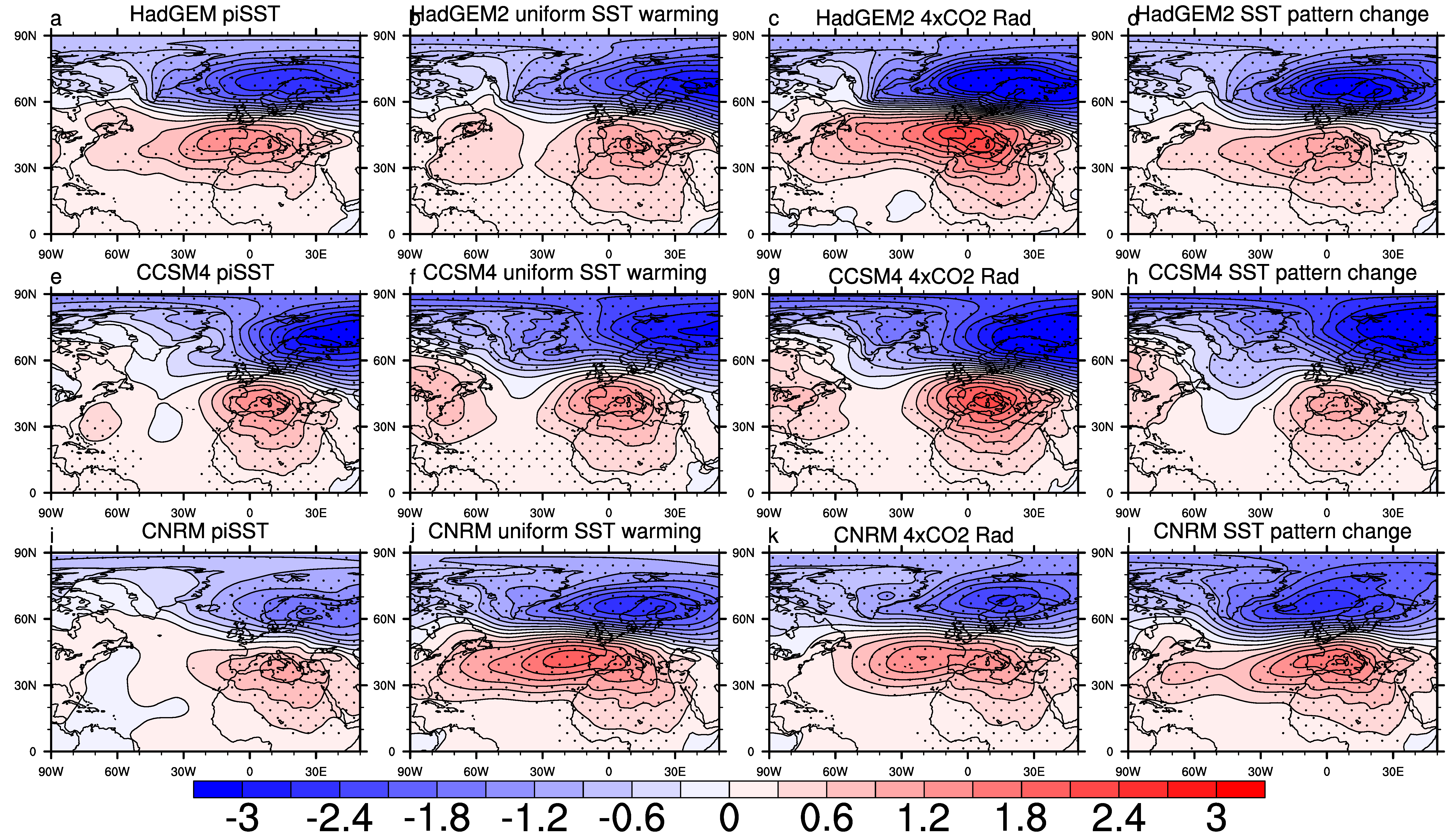

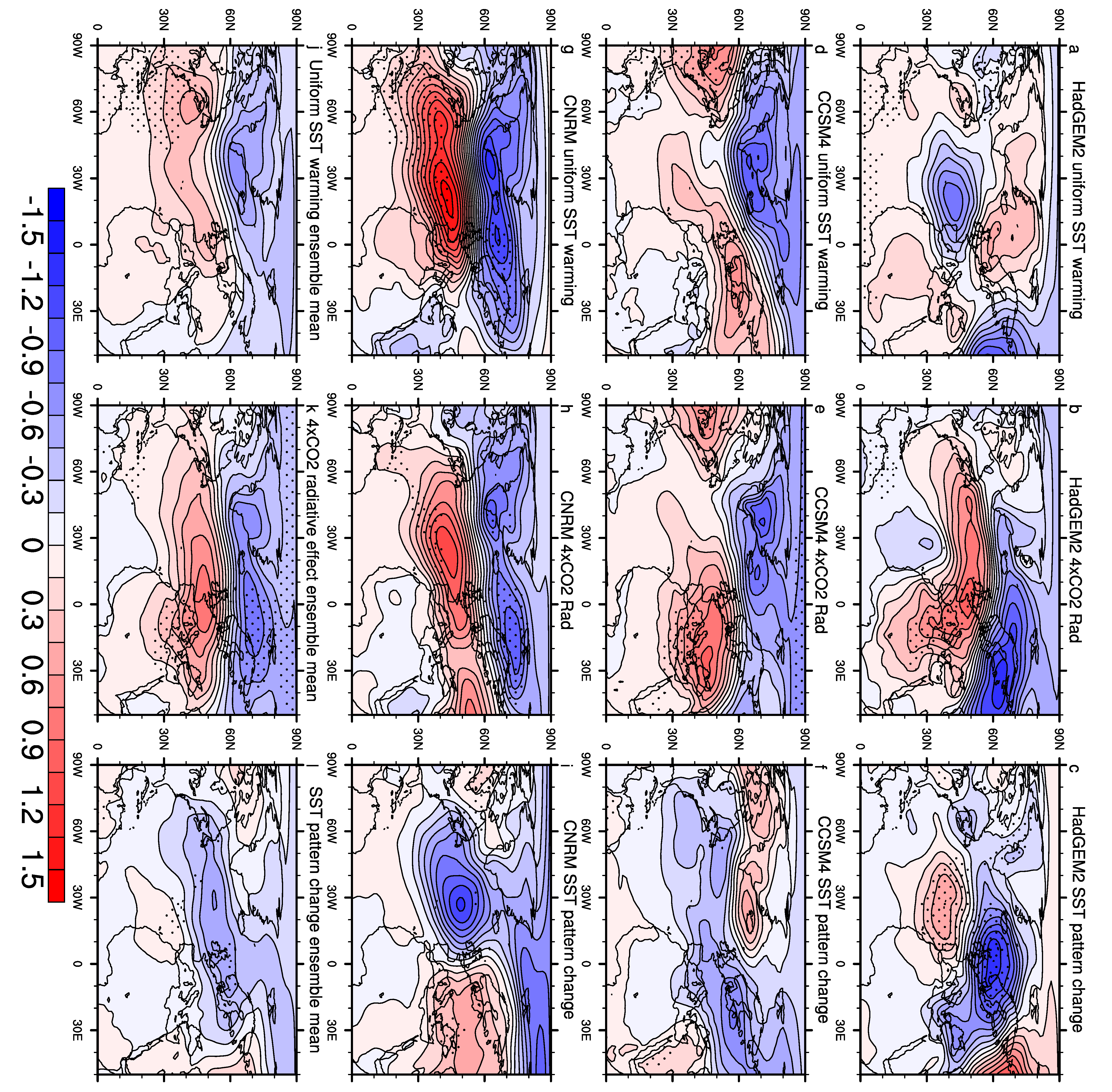

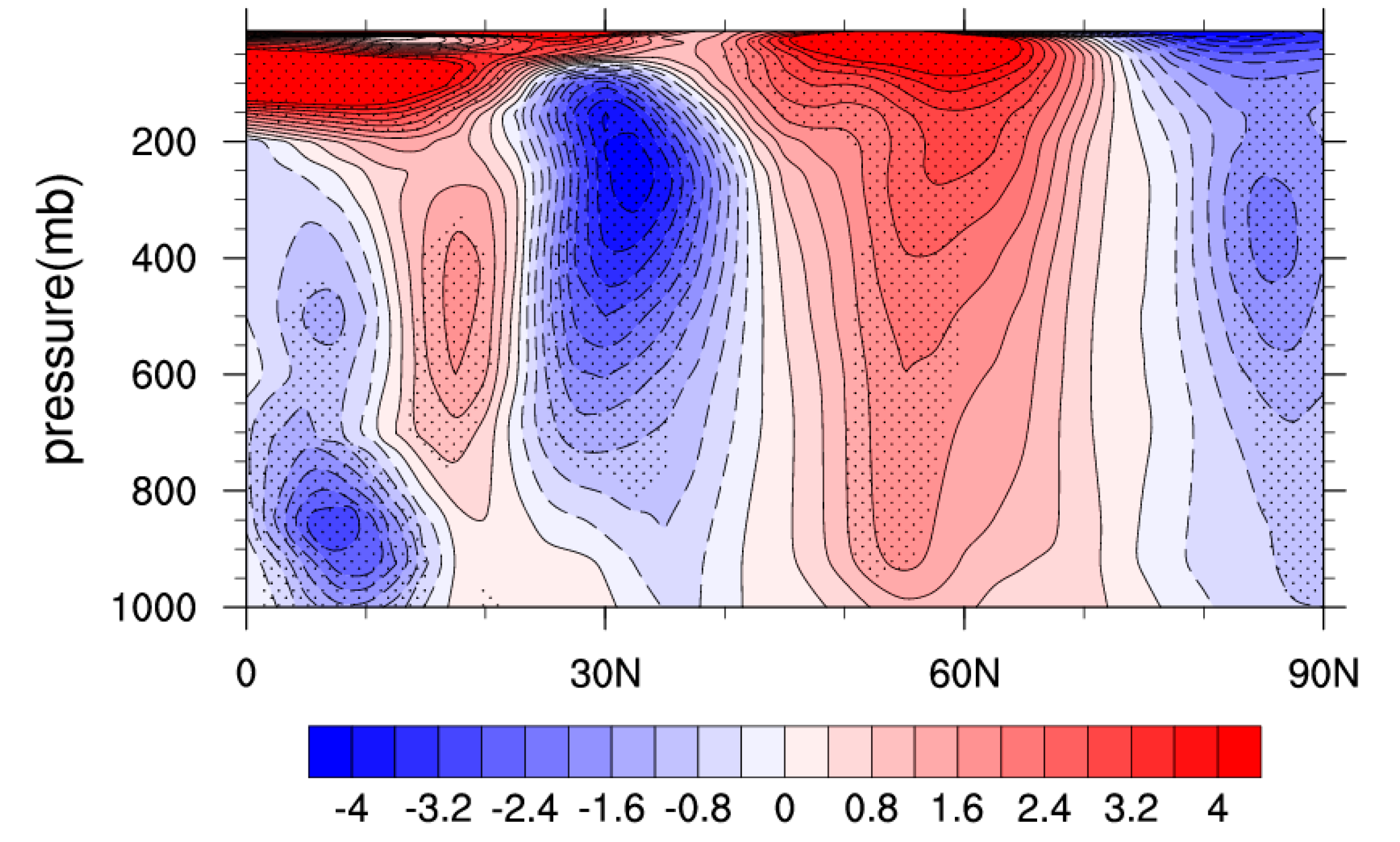

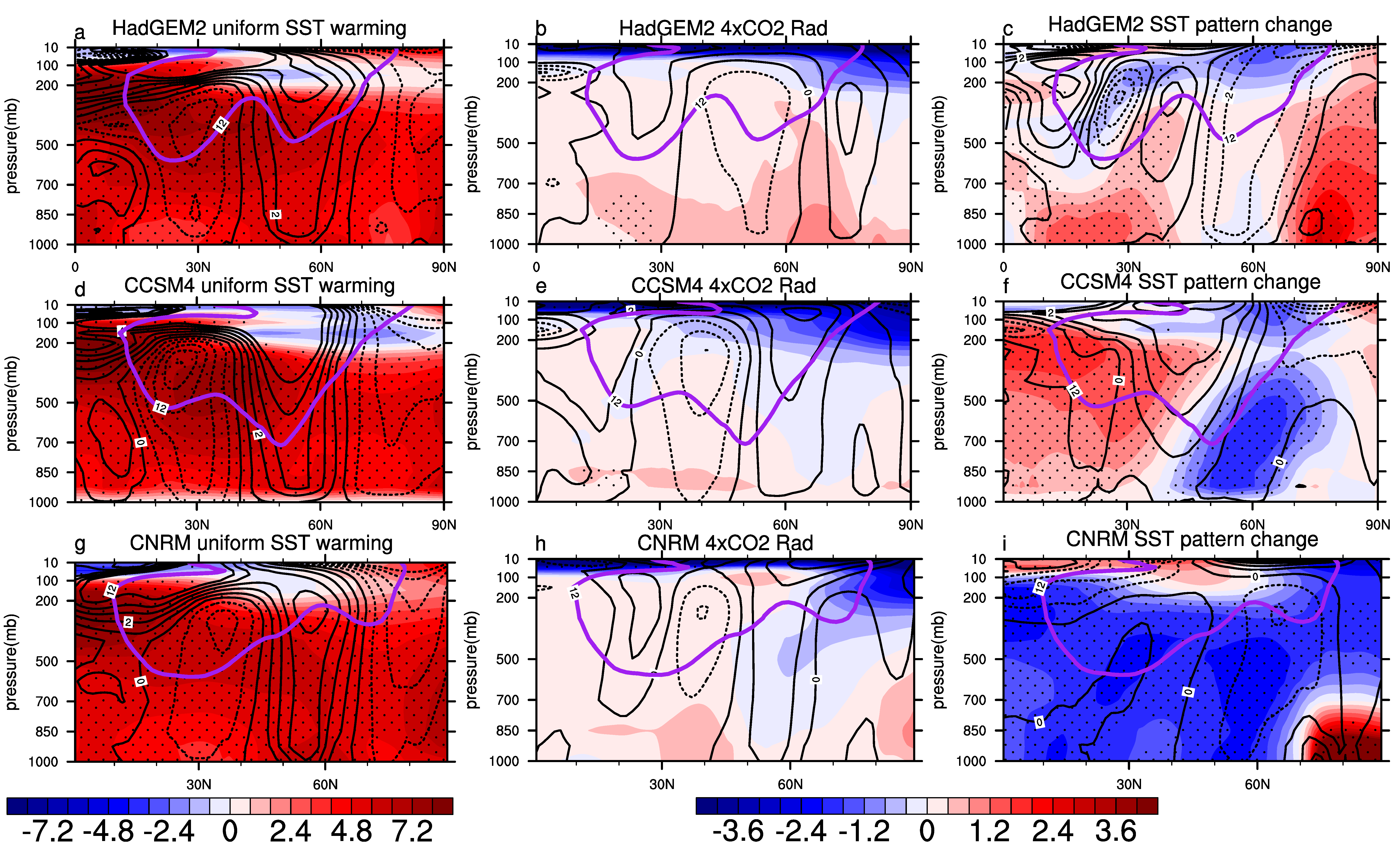


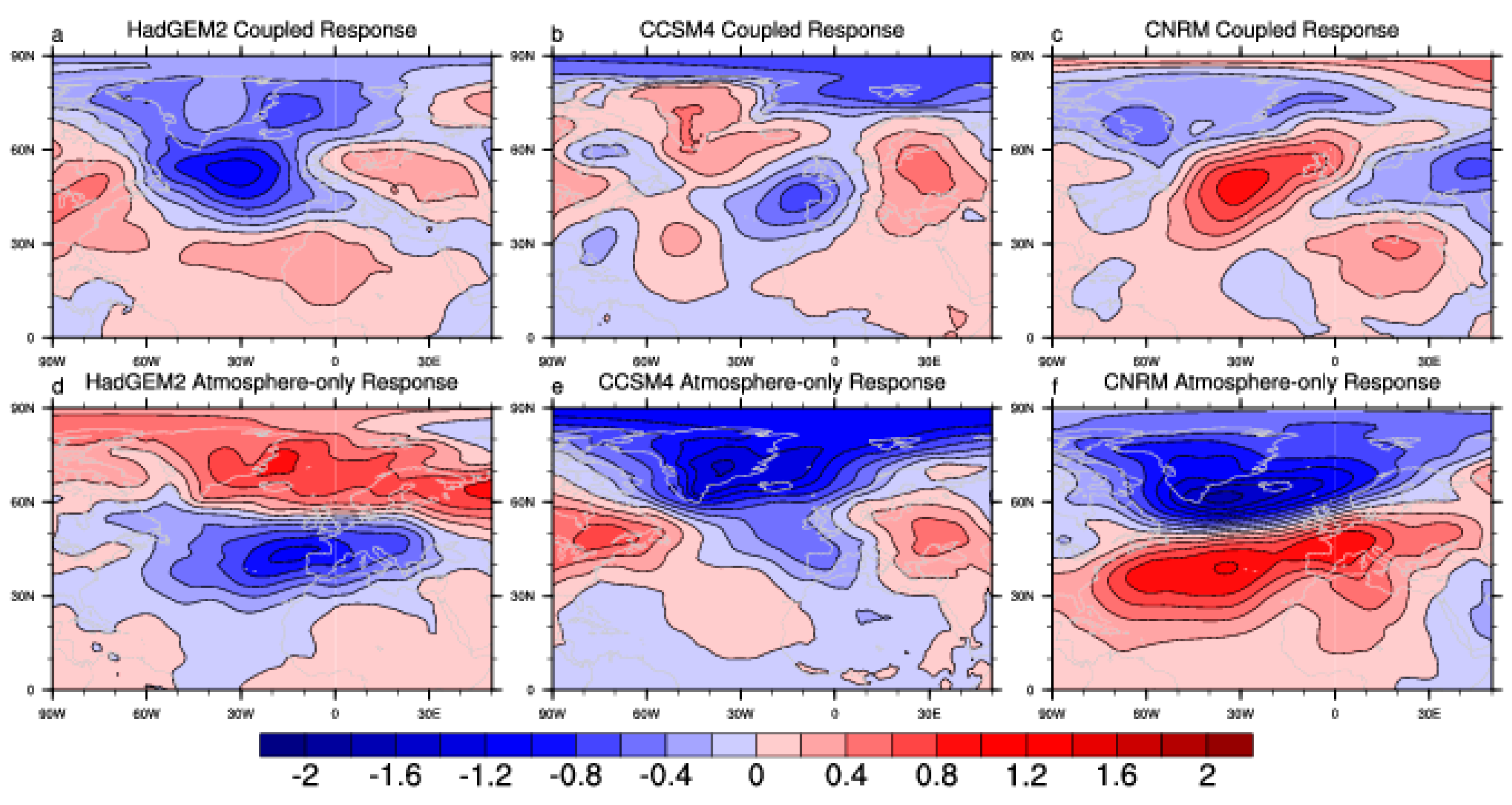
| Model | Institute | Resolution |
|---|---|---|
| HadGEM2-ES (Hadley Centre Global Environmental Model version 2 Earth System model) | Met Office Hadley Centre | 1.25° × 1.875° |
| CCSM4 (Community Climate System Model version 4) | National Center for Atmospheric Research | 1.875° × 1.25° |
| CNRM-CM5 (Centre National de Recherches Meteorologiques global Climate Model) | Centre National de Recherches Meteorologiques/Centre Europeen de Recherche et Formation Avanceesen Calcul Scientifique | 1.4° × 1.4° |
| Experiment | SSTs | CO2 |
|---|---|---|
| piControl | Pre-industrial | Pre-industrial |
| piSST | Forced with Years 101–130 of SSTs taken from piControl | Observation from 1979–2008 |
| piSST4K | As piSST, with uniform +4K anomaly | As piSST |
| piSST4 × CO2 | As piSST | The CO2 is quadrupled compared with piSST, but only seen by the radiation scheme |
| piSSTFuture | As piSST, with patterned anomaly from abrupt4 × CO2-piControl | As piSST |
| piSSTTot | As piSSTFuture | The CO2 is quadrupled compared with piSST, and is seen by both the radiation scheme and the plant physiological effect |
© 2018 by the authors. Licensee MDPI, Basel, Switzerland. This article is an open access article distributed under the terms and conditions of the Creative Commons Attribution (CC BY) license (http://creativecommons.org/licenses/by/4.0/).
Share and Cite
Huang, Y.; Ren, H.-L.; Chadwick, R.; Cheng, Z.; Chen, Q. Diagnosing Changes of Winter NAO in Response to Different Climate Forcings in a Set of Atmosphere-Only Timeslice Experiments. Atmosphere 2018, 9, 10. https://doi.org/10.3390/atmos9010010
Huang Y, Ren H-L, Chadwick R, Cheng Z, Chen Q. Diagnosing Changes of Winter NAO in Response to Different Climate Forcings in a Set of Atmosphere-Only Timeslice Experiments. Atmosphere. 2018; 9(1):10. https://doi.org/10.3390/atmos9010010
Chicago/Turabian StyleHuang, Yu, Hong-Li Ren, Robin Chadwick, Zhigang Cheng, and Quanliang Chen. 2018. "Diagnosing Changes of Winter NAO in Response to Different Climate Forcings in a Set of Atmosphere-Only Timeslice Experiments" Atmosphere 9, no. 1: 10. https://doi.org/10.3390/atmos9010010




